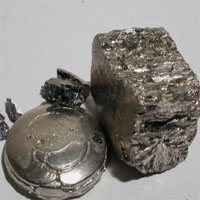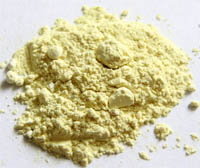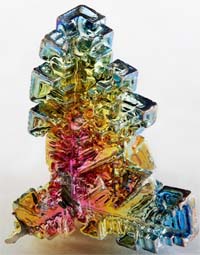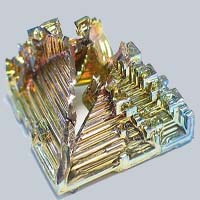
Bismuth refers to those chemical elements, what are able to show certain conditions wuth the basic properties (characteristic for metals) and acid (such as nonmetals). This chemical element has predominant basic properties, so, in a chemical reaction, this element behaves like a metal.
One of the properties of bismuth is particularly - metallic luster. Surface of bismuth has a thin layer of metal oxide that protects it from damage and gives a beautiful color with different shades.
In the earth's crust it is also available, but per unit of mass of the Earth with weight, it contains only 0,00002%.

In natural conditions this metal can be found in a free state, and as chemical compounds with oxygen (the oxide of bismuth Bi2O3) and sulfur (Bi2S3).
If we talk about bismuth as a pure metal, it is metal a pinkish-white color with a density of 9.8 kg/cm3 (not much heavier than iron with density is 7.8 kg/cm3).
The basis for the use of this metal is its use as a coolant in nuclear reactors, and the use it as an alloying element in alloys of metals. For example, if we melt bismuth, lead, tin and cadmium it is possible to get an alloy that has a melting point of only 700C.
Chemical properties of bismuth


Chemical properties of bismuth quite inert, it is allowing it to not react with oxygen (to oxidize) at room and elevated temperatures and not react with the some acids. But if it is strongly heated, it burns and form oxide Bi2O3:
4Bi + 3O2 →2Bi2O3
The oxide of bismuth shows all basic properties and when dissolved in acids it forms salts.
Reaction with hydrochloric acid and with dilute sulfuric acid does not occur. To dissolve bismuth you can use not concentrated nitric acid or concentrated sulfuric acid. At the reaction with nitric acid the nitrate of bismuth is formed with release of nitric oxide:
Bi + 4HNO3 →Bi(NO3)3 + NO + 2H2O
The reaction with sulfuric acid is same as reaction with nitric acid - with the formation of sulphate of bismuth and release of sulphurous gas and water:
2Bi + 6H2SO4 → Bi2(SO4)3 + 3SO2 +6H2O
Hydroxide of bismuth - white water-insoluble powder. It can be obtained, for example, if to act to a soluble salt of the metal with strong alkali:
Bi(NO3)3 + 3NaOH →Bi(OH)3 precipitate + 3NaNO3
If to act to a soluble salt of bismith with sulfurous acid, then drops a black-brown precipitate of sulphide of bismuth Bi2S3
Bismuth in chemical reactions does not form tiosalts (salts with dual acid residue).